Reflected infrared photography:
Films page 1
Emulsions have to be specially sensitized to radiation beyond the red region. Infrared sensitizing dyes were discovered early this century, but infrared materials were not widely available until the 1930's. Indeed panchromatic film was not widely used until the 1940s (See Kodak advertisement comparing the reproduction of orthochromatic and panchromatic films, Figure 36). Through successive discoveries, the sensitivity given by sensitizing dyes have been extended in stages to the limit of 1350nm. Only specialized spectroscopic plates extend this far up the spectrum, conventional infrared films available today only being sensitive to about 900nm.
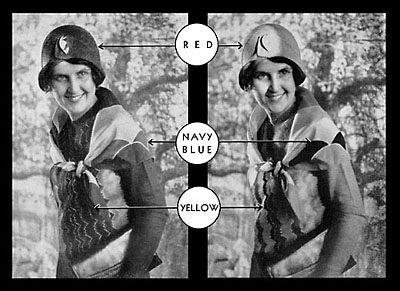
Figure 36 (above). A Kodak advertisement from the 1930's extolling the virtues of the new panchromatic film over the existing orthochromatic film. It must be remembered that for the first hundred years of photography's history film was insensitive to red, or indeed infrared.
In 1958 Engel surveyed the range of films for infrared, and found that eight manufacturers collectively supplied over twenty different emulsions. By the early 1990s the range had declined to just two manufacturers (Figure 37) but thanks to the interest in infrared photography by mass market amateur consumers there have been several new introductions in recent years.
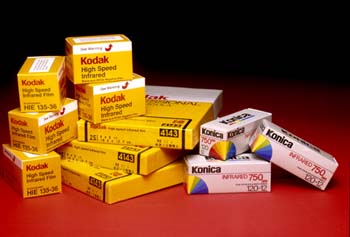
Figure 37 (above). By the 1990s the range of IR films had declined to two manufacturers.
 Kodak supplies probably the most widely used and universally available high speed black-and-white infrared film known by the HIE or HIS codes (depending on country). This film is available in the 35mm format (HIE-135); as cassettes, or as 150 foot rolls. In it's aerial configuration (HIE 2443) it is also available as 70mm 150ft rolls or 9.5 inch wide 125, 200 or 400 foot rolls coated onto an Estar base. The 4x5 sheet film (HIE 4143) was recently withdrawn from the market by Kodak due to declining demand. The emulsion has a moderately high contrast and an infrared sensitivity peaking between 750 and 950nm - the furthest into the infrared spectrum of any commonly available film (Figure 38). It is inherently grainy. This film has no anti-halation layer and therefore exhibits two associated effects: 'light piping' and halated highlights. The 'light piping' means that infrared radiation entering the film structure, at say the leader, is able to internally reflect within the film base along into the bulk of the film within the cassette. This problem is exacerbated by the felt light trap on the cassette being less effective in infrared than in visible light. This means therefore that the film is very susceptible to fogging and must be loaded/unloaded into the camera in total darkness. The lack of anti-halation layer is also the reason why bright point sources of light in the scene record on this film as having 'halos' around them. The infrared passes through the silver halide and reflects from the back of the film or camera pressure plate to create secondary halo images. There are numerous reports of this causing problems with different camera pressure plates. This film is also famous for exhibiting processing artefacts such as uneven density and pinholes - more of this in processing. Kodak also warn that this film is susceptible to static 'flash' fogging in very dry conditions and suggest that it may even be necessary to ground the camera to avoid a build-up of static (although the authors have used this film extensively in the Australian outback - very low humidity and temperatures in excess of 40° Centigrade - with no obvious static marking). The film base is actually grey and so printing times are extended. Despite all these difficulties HIE remains the most widely used infrared film for scientific purposes. Kodak supplies probably the most widely used and universally available high speed black-and-white infrared film known by the HIE or HIS codes (depending on country). This film is available in the 35mm format (HIE-135); as cassettes, or as 150 foot rolls. In it's aerial configuration (HIE 2443) it is also available as 70mm 150ft rolls or 9.5 inch wide 125, 200 or 400 foot rolls coated onto an Estar base. The 4x5 sheet film (HIE 4143) was recently withdrawn from the market by Kodak due to declining demand. The emulsion has a moderately high contrast and an infrared sensitivity peaking between 750 and 950nm - the furthest into the infrared spectrum of any commonly available film (Figure 38). It is inherently grainy. This film has no anti-halation layer and therefore exhibits two associated effects: 'light piping' and halated highlights. The 'light piping' means that infrared radiation entering the film structure, at say the leader, is able to internally reflect within the film base along into the bulk of the film within the cassette. This problem is exacerbated by the felt light trap on the cassette being less effective in infrared than in visible light. This means therefore that the film is very susceptible to fogging and must be loaded/unloaded into the camera in total darkness. The lack of anti-halation layer is also the reason why bright point sources of light in the scene record on this film as having 'halos' around them. The infrared passes through the silver halide and reflects from the back of the film or camera pressure plate to create secondary halo images. There are numerous reports of this causing problems with different camera pressure plates. This film is also famous for exhibiting processing artefacts such as uneven density and pinholes - more of this in processing. Kodak also warn that this film is susceptible to static 'flash' fogging in very dry conditions and suggest that it may even be necessary to ground the camera to avoid a build-up of static (although the authors have used this film extensively in the Australian outback - very low humidity and temperatures in excess of 40° Centigrade - with no obvious static marking). The film base is actually grey and so printing times are extended. Despite all these difficulties HIE remains the most widely used infrared film for scientific purposes.
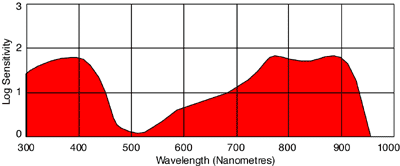
Figure 38 (above). Spectral sensitivity curve for Kodak HIE 135 black-and-white film; the most universally used true infrared film on the market.
 Konica have introduced a black-and-white infrared emulsion in 120 roll film and 35mm, 24 exposure, formats - Konica 750. As its name implies, this film has a peak spectral sensitivity at 750nm and, as can be seen from the spectral response curve show in Figure 39, only has sensitivity extending to 800nm . Strictly speaking, therefore, this film is an extended red film not an infrared film. The film has a single, thin, infrared sensitive emulsion layer coated onto a coloured anti-halation tri-acetate base. It has fine granularity, high contrast and excellent resolving power. It is slower than the Kodak products but much less grainy. The presence of an anti-halation backing removes the halo and light piping effects common with the Kodak films. This film is extremely popular with pictorial photographers who use it with a Wratten 25 (red) filter. The limited infrared sensitivity means that care in the selection of a filter for use with this film is therefore imperative; the narrow-cut Wratten 87A, B, or C, for example, would lead to virtually no result. Some workers have reported availability problems with this emulsion, which is apparently produced only once a year in February, and in common with all infrared film has a short shelf life. Konica have introduced a black-and-white infrared emulsion in 120 roll film and 35mm, 24 exposure, formats - Konica 750. As its name implies, this film has a peak spectral sensitivity at 750nm and, as can be seen from the spectral response curve show in Figure 39, only has sensitivity extending to 800nm . Strictly speaking, therefore, this film is an extended red film not an infrared film. The film has a single, thin, infrared sensitive emulsion layer coated onto a coloured anti-halation tri-acetate base. It has fine granularity, high contrast and excellent resolving power. It is slower than the Kodak products but much less grainy. The presence of an anti-halation backing removes the halo and light piping effects common with the Kodak films. This film is extremely popular with pictorial photographers who use it with a Wratten 25 (red) filter. The limited infrared sensitivity means that care in the selection of a filter for use with this film is therefore imperative; the narrow-cut Wratten 87A, B, or C, for example, would lead to virtually no result. Some workers have reported availability problems with this emulsion, which is apparently produced only once a year in February, and in common with all infrared film has a short shelf life.

Figure 39 (above). Spectral sensitivity curve of the Konica 750 IR film widely used by pictorial photgraphers. Whilst clearly lacking the full range infrared extension of the Kodak it has much finer grain structure.
 Ilford now supply SFX 200 in 35mm, 36 exposure cassettes and as 120 roll film (it was previously only available as SP816T - a special purpose traffic surveillance film). Ilford themselves describe this film as "a black-and-white camera film with extended red sensitivity for creative photography." The spectral response peaks at about 720 nm and falls rapidly to zero at 780nm. It is coated onto an acetate base with an anti-halation backing. It is a medium speed film with wide exposure latitude, is compatible with all common developers, and exhibits fine grain and wide tonal range. Like the Konica product its ease of use has made it very popular with pictorial photographers but the same caveat about spectral sensitivity exists: the use of true infrared filters (Wratten 87 series) would result in no image. The lack of true infrared sensitivity, combined with severe reciprocity effects, limit this films application to science and medicine. Ilford now supply SFX 200 in 35mm, 36 exposure cassettes and as 120 roll film (it was previously only available as SP816T - a special purpose traffic surveillance film). Ilford themselves describe this film as "a black-and-white camera film with extended red sensitivity for creative photography." The spectral response peaks at about 720 nm and falls rapidly to zero at 780nm. It is coated onto an acetate base with an anti-halation backing. It is a medium speed film with wide exposure latitude, is compatible with all common developers, and exhibits fine grain and wide tonal range. Like the Konica product its ease of use has made it very popular with pictorial photographers but the same caveat about spectral sensitivity exists: the use of true infrared filters (Wratten 87 series) would result in no image. The lack of true infrared sensitivity, combined with severe reciprocity effects, limit this films application to science and medicine.
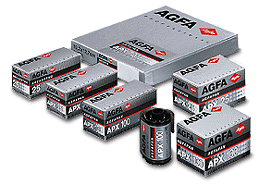 Agfa Agfapan APX 200S and 400s are sometimes quoted as being useful for "infrared photography effects." These are again medium speed black-and-white films with extended red sensitivity that started life as a traffic surveillance films and have been re-packaged for the pictorial/creative photographer. The 200ISO version is available in 35mm cassettes or 17 metre 35mm rolls, whereas the 400ISO version is only available as 17, 30.5 or 48.8 metre rolls and they are all coated onto a thin polyester base with anti-halation backing. The film exhibits reasonable sensitivity between 600 and 670nm and is therefore only a mildly extended red film. It is a medium speed film with wide exposure latitude and exhibits fine grain and wide tonal range. It can only be used with a red filter - true infrared is not possible with this film Agfa Agfapan APX 200S and 400s are sometimes quoted as being useful for "infrared photography effects." These are again medium speed black-and-white films with extended red sensitivity that started life as a traffic surveillance films and have been re-packaged for the pictorial/creative photographer. The 200ISO version is available in 35mm cassettes or 17 metre 35mm rolls, whereas the 400ISO version is only available as 17, 30.5 or 48.8 metre rolls and they are all coated onto a thin polyester base with anti-halation backing. The film exhibits reasonable sensitivity between 600 and 670nm and is therefore only a mildly extended red film. It is a medium speed film with wide exposure latitude and exhibits fine grain and wide tonal range. It can only be used with a red filter - true infrared is not possible with this film
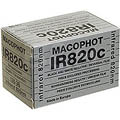 Maco are a new player in the infrared film market ; they are a division of Hans O. Mahn & Co in Hamburg, Germany. At Photokina 2000 they released details of a prototype infrared film Maco IR 820c which then went into experimental production in 2001 and final product release late in that year. It is now widely available in 35mm, DX coded, 36 exposure cassettes, 120 roll film and 4x5 sheet film. It is a cubic crystal emulsion with spectral sensitivity extending to 820nm (Figure 40), coated onto a clear polyester base with antihalation backing. It is a fine grain, high resolution emulsion designed for scientific and technical applications (although it is also likely to be well received by pictorial photographers - which may help keep its viability in the marketplace). The anti-halation layer prevents the common problems associated with the Kodak HIE film and is removed prior to development by using a water bath. Like HIE this film must be handled in complete darkness. Maco are a new player in the infrared film market ; they are a division of Hans O. Mahn & Co in Hamburg, Germany. At Photokina 2000 they released details of a prototype infrared film Maco IR 820c which then went into experimental production in 2001 and final product release late in that year. It is now widely available in 35mm, DX coded, 36 exposure cassettes, 120 roll film and 4x5 sheet film. It is a cubic crystal emulsion with spectral sensitivity extending to 820nm (Figure 40), coated onto a clear polyester base with antihalation backing. It is a fine grain, high resolution emulsion designed for scientific and technical applications (although it is also likely to be well received by pictorial photographers - which may help keep its viability in the marketplace). The anti-halation layer prevents the common problems associated with the Kodak HIE film and is removed prior to development by using a water bath. Like HIE this film must be handled in complete darkness.
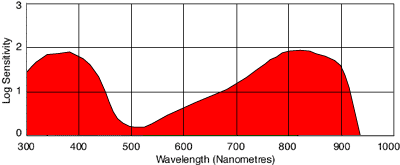
Figure 40 (above). Spectral sensitivity curve of the Maco 820c IR film - a true infrared film newly introduced onto the market from a German manufacturer.
References:
- Engel, C., 1958. "Present-day materials for infrared photography," Med. Biol. Illustr. 8:89-91.
|


![]() Home > Articles > Infrared Photography > Reflected infrared photography: Films
Home > Articles > Infrared Photography > Reflected infrared photography: Films